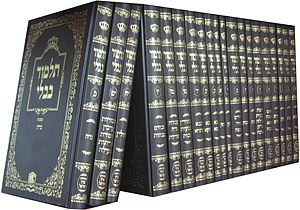While I did not have the privilege to join the 90,000+ Jews who filled the MetLife Stadium Wednesday night, this milestone in Jewish life cannot be underestimated.
The Jews have endured countless public burnings of the Talmud over the centuries since the first recorded incident in 1242 when twenty-four wagons of books totaling thousands of hard-written volumes were burned in Paris. Centuries of of more burnings ensued. Just 80 years ago, the Nazis collected and burned thousands of copies of Talmud. Many more thousands of copies of the Talmud burned in the synagogues, study halls, and homes during the duration of the Shoah.
Yet, the attempt to eradicate Jewish learning has failed. It may be that more Jews study the Talmud today than at any time in Jewish history.
Getting Daf Yomi, the daily study of a page (back and front) of Talmud a day, off the ground did not happen overnight. When Rabbi Moshe Shapiro proposed the Daf Yomi at the first World Congress of the World Agudath Israel in Vienna on August 16th 1923, it was greeted warmly, but it went against convention. Pages of Talmud are worlds unto themselves. There are a myriad of commentaries on every page, and deciphering and analyzing each section can take days, weeks, and at times months. Some greeted the fast paced study with skepticism because it was such a radical notion.
But since Daf Yomi was an effort in Jewish unity it ultimately has succeeded beyond anyone’s expectations since Jewish tradition teaches that blessing comes from such efforts. People all over the world are nowthinking, discussing and struggling with the same text.
Rabbi Shapiro described the philosophy behind Daf Yomi this way:
What a great thing! A Jew travels by boat and takes gemara Berachot under his arm. He travels for 15 days from Eretz Yisrael to America, and each day he learns the daf. When he arrives in America, he enters a beis medrash in New York and finds Jews learning the very same daf that he studied on that day, and he gladly joins them. Another Jew leaves the States and travels to Brazil or Japan, and he first goes to the beis medrash, where he finds everyone learning the same daf that he himself learned that day. Could there be greater unity of hearts than this?
For many decades my teacher of saintly memory Rabbi Haskel Besser was the chairperson of the International Daf HaYomi Commission at Agudas Yisroel. The commission was tasked with promoting and spreading the Daf Yomi movement, and he spoke every 7 1/2 years at the annual Siyum HaShas. Sadly, he passed away nearly three years ago. Yet, he was recognized from the dias for his contribution to the movement.
Rabbi Besser had many reasons to promote the movement. One of his critical realizations was that for the average working Jews a 30-60 minute Talmud session every day would keep them interested and engaged. They would look forward to what was on the next page each day. Even if they themselves were not learned enough in Talmud study to decipher each page, they could follow along on this Talmudic journey alongside scholars. Thankfully, he lived long enough to see the websites, podcasts, videos, and multiple editions of the Talmud in many languages all geared towards daily Talmud study. The success of the Daf Yomi movement is a tribute to his vision and efforts.
The Daf Yomi movement should be an example and shake the foundations of Jewish institutions seeking ways to keep Jews Jewish. While 90,000+ Jews represent only a fraction of the American Jewish population, no other movement could ever succeed at drawing 90,000 Jews together for anything.
They should also see the power of Jewish learning. Being Jewish in and of itself without feeling attached to Jewish knowledge undermines efforts at stopping assimilation.
And finally, being Jewish because of heredity, a feeling, an allegiance to Israel, or an inherited set of values without attachment to some level of purpose, ritual and observance is ultimately going to fail to move the needle.
There is no reason that the Daf Yomi celebration this week needs to be the final exercise in Jewish unity until 2020. And God forbid, the next movement in Jewish unity should not be rallying for Israel during a war or crisis.
We Jews are a stiff necked people, says the Torah. Finding, promoting, and spreading a movement in Jewish unity, let alone a movement in Jewish learning among the vast majority of our people, will take time, effort and lots of money. But we see it works, so is it not worth a try?
For 100 millions dollars we could create a movement of accessible, relevant and unifying Jewish learning for those who are not learning Daf Yomi. We already see there is an interest in Jewish learning by the many websites that send out daily Torah study patterned on the daily learning of the Talmud. Clearly thousands of Jews are already involved. Is it not possible to foster a movement that brings together everyone in learning something together, every day, which builds Jewish unity and culminates in a celebration?
The grassroots movement of Daf Yomi and the celebration of finishing the cycle of learning of the Talmud inspires me to dream of what we could do and what we can achieve.






Please take a look at http://www.themercava.com
I believe this is the answer to: “create a movement of accessible, relevant and unifying Jewish learning”
http://www.themercava.com/